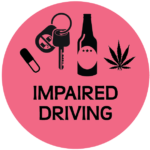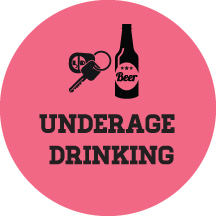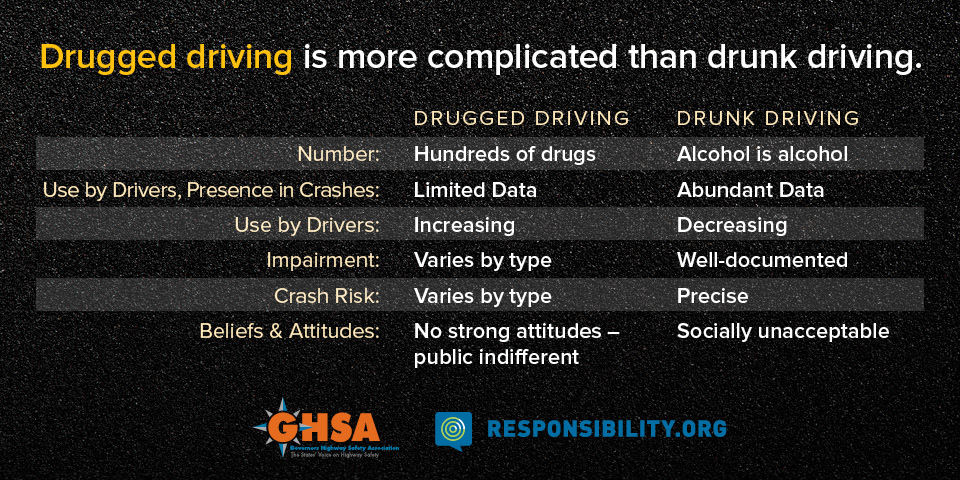 Drivers between 16-20 are 17 times more likely to die in a crash when they have a blood alcohol content (BAC) of .08% compared to when they have not been drinking.1
Drivers between 16-20 are 17 times more likely to die in a crash when they have a blood alcohol content (BAC) of .08% compared to when they have not been drinking.1
The problem of driving under the influence of alcohol:
- TDS teens agree – driving under the influence of marijuana (92%) and alcohol (96%) is UNACCEPTABLE.2
- Young drivers are less likely than adults to drive after drinking alcohol, but their crash risk is substantially higher when they do. This is especially true at low and moderate blood alcohol concentrations (BACs).3
- In 2021, 14.1% of high school students 16 and older reported riding with a driver who had been drinking alcohol in the past 30 days.4
- Drivers are less likely to use restraints when they have been drinking.5
- In 2022, 28% of 15-20-year older drivers involved in fatal crashes had a BAC greater than .08.6
- Most of those killed in alcohol-related crashes involving teen drivers are the young drivers themselves and their passengers.6
Zero Tolerance Law and other consequences of driving under the influence:
- Zero tolerance law makes it illegal per se (in and of itself) for persons under the age of 21 to drive with any measurable amount of alcohol in their blood.7
- Violators of underage drinking laws often face a trip to jail, the loss of their driver’s license, and dozens of other unanticipated expenses including attorney fees, court costs, and other fines.7

- A DUI conviction follows a teen, so there is the added embarrassment, humiliation, and potential loss and consequence related to academic eligibility, college acceptance, scholarship awards, and more.7
- Increased efforts by local law enforcement make the chances of getting caught even greater.
- The Texas Department of Transportation conducted a study that found that a first-time offender could expect to pay between $5,000 and $24,000 for DWI arrest and conviction.8
Drugged Driving
- In 2022, drugs were present in 44% of the fatally injured drivers with a known test result, more frequently than alcohol was present.9
- According to FARS Data, Cannabinoid use in fatally injured drivers has steadily increased from 2016 to the present as legalization has begun.6
- After alcohol, marijuana is the drug most often found in the blood of drivers involved in crashes.10
- Drug-impaired driving is more complex than alcohol-impaired driving for many reasons.11

- In 2022, alcohol and other drug prevalence among seriously and fatally injured drivers at the five trauma center study sites found:12
- More than 32% had measurable alcohol in their systems
- over 28% tested positive for the presence of cannabinoids and,
- over 13% tested positive for opioids.
The Effects of Drugged Driving:
- Alprazolam(Xanax XR, Niravam), is an anti-anxiety medication in the benzodiazepine family, the same family that includes diazepam (Valium), clonazepam (Klonopin), lorazepam (Ativan), flurazepam (Dalmane), and others. These medications are downers and can cause confusion, blurry vision, and vertigo. Not good effects to get behind the wheel.
- Amphetamine and dextroamphetamine (Adderall) are used for treating attention-deficit hyperactivity disorder (ADHD) and narcolepsy. Amphetamines stimulate the brain by increasing the level of neurotransmitters, dopamine, and norepinephrine, in the brain. While it may boost your ego, Adderall can increase your heart rate and puts drivers at risk for having a seizure or stroke.
- The effects of MDMA (Methylenedioxymethamphetamine, commonly known as ecstasy (E) can be confusion, severe anxiety, and decreased motor skills. Taking any drug can impair your driving skills, putting you and others more at risk for a car crash.
- OxyContin(oxycodone) is an opioid pain medication. Painkillers are one of the most commonly abused drugs by teens, after tobacco, alcohol, and marijuana. Opioids are highly addictive and can cause nausea, confusion, and breathing problems behind the wheel.
- Not only will driving under the influence of marijuana earn you a DUI, but it will significantly impair judgment, motor coordination, and reaction time – perfect conditions for causing a crash.
What to do about impaired driving:
- Driving after even one drink is just not worth it. Ride with a sober friend, ask someone else to drive, or call a parent or older sibling.
- Driving after one puff or consuming edible marijuana (THC) is not worth risking your life and the life of others on the road. Find a sober ride by taking a cab, rideshare, or public transportation.
- Food, coffee, or exercise will not reduce the effects of alcohol or drugs in your system. Only time decreases the effects of alcohol and drugs.
- Don’t believe you can “fool” a police officer. They are trained to look for tell-tale signs of a driver who is under the influence.
- If a friend has been drinking or taking drugs and is about to drive, SPEAK UP. Offer to drive, take the keys, or call a parent.
- Never get in the car with a driver who has been drinking or doing drugs. Everyone reacts differently. Always assume that the person is too impaired to drive. Follow that Better Safe Than Sorry mantra.
Sources:
- Center for Disease Control, https://www.cdc.gov/vitalsigns/mobile-test/bingedrinkingfemale/index.html#:~:text=Young%20drivers%20(ages%2016%2D20,but%20more%20can%20be%20done
- Texas A&M Transportation Institute, 2022. Based on the 2022-2023 Teen Driver Annual Surveys
- IIHS, 2019. https://www.iihs.org/topics/fatality-statistics/detail/teenagers#alcohol-involvement
- Center for Disease Control, 2021. Youth Risk Behavior Survey 2021. https://nccd.cdc.gov/youthonline/App/Results.aspx?LID=XX
- NHTSA, Traffic Safety Facts, 2007 https://crashstats.nhtsa.dot.gov/Api/Public/ViewPublication/811001
- NHTSA FARS, 2022
- Texas DPS, 2020. Alcohol and Minors – Texas has ZERO TOLERANCE. https://www.dps.texas.gov/internetforms/getForm.ashx?id=DL-20.pdf
- TxDOT, https://www.txdot.gov/inside-txdot/division/traffic/safety/sober-safe/intoxication.html#:~:text=What%20are%20the%20penalties%20for%20a%20DWI%3F&text=Up%20to%20a%20%242%2C000%20fine,license%20up%20to%20a%20year.
- NIH, Drug Impaired Driving. https://nida.nih.gov/publications/drugfacts/drugged-driving
- National Institute on Drug Abuse, https://nida.nih.gov/publications/drugfacts/drugged-driving
- GHSA, Drug-Impaired Driving: A Guide for States, 2017. https://www.ghsa.org/resources/drugged-driving-2017
- NHTSA, Traffic Safety Facts 2022. https://crashstats.nhtsa.dot.gov/Api/Public/ViewPublication/813578
Updated, October 2024
